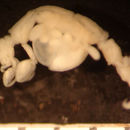en
names in breadcrumbs


Length: 3-11mm. Head with median triangular, anteriorly pointing spine; rest of body with paired and unpaired tuberculations on all pereonites. Antenna 1 longer than cephalon plus pereonite 2, peduncle articles 2 and 3 setose; antenna 2 longer than peduncle of antenna 1, flagellum with long swimming setae. Gnathopod 1 with weakly serrate grasping margin to propodus and dactylus. Gnathopod 2 propodus very large, breadth more than half length, palmar margin with median ventral-pointing poison spine, and distal rounded or rectangular projection. Dactylus thick proximally, tapered distally, grasping margin denticulate. Basis attached at middle of pereonite 2, having large antero-lateral ridge. Gills oval. Pereopods 5 to 7 increasing in length, propodus palm concave, grasping spines proximal. Female differs from male in that antenna 1 is not setose, gnathopod 2 attached anteriorly and having small propodus with proximal grasping spine and median and distal palmar projections.
California, Oregon, Washington, British Columbia
Caprellid, “Ghost” or “Skeleton” shrimps, so called for their skeletal appearance. Amphipod crustaceans, easily distinguished by the elongate stick-like body form and reduction of the abdominal appendages. Head is generally fused with pereonite 1. Pereopods on first 2 segments (pereonites) are most flexible and called gnathopods; gnathopods 2 being the largest, used in defense, feeding and substrate attachment. In many species pereopods 3 and 4 may also be reduced or absent. Gills on pereonites 3 + 4, rarely on pereonite 2. Pereopods 5 - 7 much smaller than 1 + 2, used for clinging to the substratum. In females, brood plates (öostegites) develop on pereonites 3 + 4. Much remains to be learnt about their biology, ecology and in many cases changing distributions.
On hydroids (such as Algaophenia and campanulariids), bryozoans, coralline algae, and kelp holdfasts.
1 intersex individual found. C. angusta, C. incisa and C. verrucosa are all members of the ‘acutifrons’ group, typically similar in their general body shape, the shape and armature of the second gnathopods, and the proportions of the antennae. C. angusta is typically the most smooth, and C. verrucosa with the most extreme large blunt spines. C. incisa can be distinguished from C. verrucosa by its much smaller tuberculations, finely setose antenna 1 and very large propodus and antero-lateral ridge on gnathopod 2. C. angusta can be distinguished from C. incisa by its almost smooth dorsal surface, normal sized gnathopod 2 propodus and basal ridge, anterior attachment of gnathopods 2, absence of pleura and of setae on antenna 1. See Laubitz 1970 for table comparing these species.
National Museum of Natural History, Washington DC: (NMNH) 172360 Monterey Bay + Clayoquat; specimens id’ed as C. acutifrons in 1945; McCain re-Id’ed as C. incise 1960